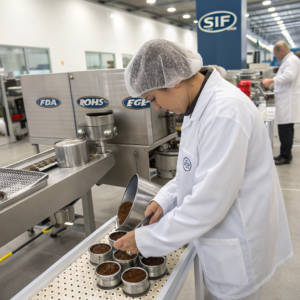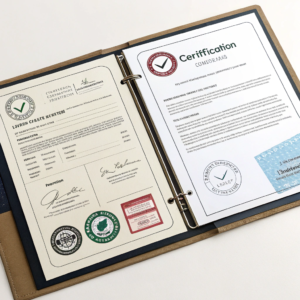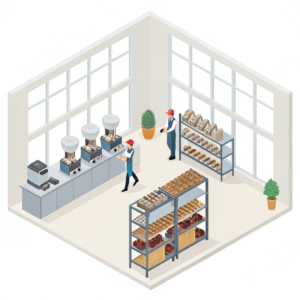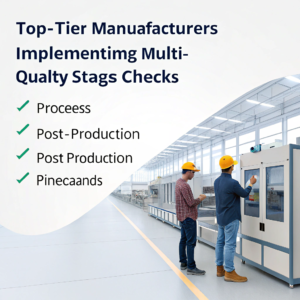Finding reliable coffee accessory manufacturers in China feels like searching for a needle in a haystack. Many distributors suffer from inconsistent quality, leading to customer complaints and damaged reputation. The right manufacturing partner with robust quality controls makes all the difference.
Top-tier coffee accessory manufacturers in China distinguish themselves through comprehensive certification systems (ISO 9001, IATF16949, HACCP), advanced testing protocols, customized inspection plans, 5S management systems, and multi-stage quality checks throughout production rather than just inspecting final products.

During my 15 years working with Chinese manufacturers, I've witnessed firsthand the stark contrast between standard factories and premium production facilities. The difference lies primarily in their approach to quality control. Let me share what truly separates the elite manufacturers from the mediocre ones.
How do certification standards separate elite manufacturers from average factories?
Standard factories often claim certifications they don't actually possess. This misrepresentation leads to compliance issues, customs problems, and potentially dangerous products that fail to meet international safety standards.
Elite coffee accessory manufacturers maintain legitimate certifications like ISO 90011, IATF16949, and HACCP2, ensuring compliance with international quality standards. These certifications require rigorous documentation, regular audits, and continuous improvement processes that standard factories typically avoid.

The certification landscape serves as the foundation for quality manufacturing in China's coffee accessory industry. Unlike standard factories that may display certification logos without actual compliance, premium manufacturers invest significantly in obtaining and maintaining legitimate credentials. When I visit top-tier facilities, I always check for documentation transparency, audit history, staff awareness of requirements, and proactive renewal planning.
The most telling difference is how these certifications influence daily operations. In standard factories, you'll typically see certifications framed on walls but disconnected from actual processes. In contrast, premium manufacturers integrate requirements into their standard operating procedures. For example, ISO 9001 principles become evident in their document control systems, internal audit programs, and management review meetings.
HACCP certification is particularly crucial for coffee accessory manufacturers, as it ensures food safety in products that come into contact with consumables. Elite manufacturers apply HACCP principles by identifying critical control points in production, establishing monitoring procedures, and implementing corrective actions when deviations occur. This systematic approach creates a foundation for consistent quality that standard factories simply cannot match without the proper certification framework.
What advanced testing protocols ensure superior coffee accessories?
Mass-market factories often conduct minimal testing, resulting in accessories that fail prematurely, affect beverage taste, or pose safety hazards. These shortcuts eventually cost distributors through returns and reputation damage.
Premium manufacturers implement rigorous testing protocols including fatigue tests on components, stability assessments, and power cord integrity checks. These simulate real-world stress conditions and ensure products maintain performance standards throughout their expected lifecycle.

The testing methodologies employed by elite manufacturers reveal their commitment to durability and performance. During my factory audits, I've observed significant differences in how testing is approached. Top-tier facilities invest in specialized equipment and dedicate substantial resources to testing processes that standard factories consider unnecessary expenses.
Critical Testing Differentiators
| Test Type | Standard Factory Approach | Premium Manufacturer Approach |
|---|---|---|
| Material Testing | Basic visual inspection | Spectroscopic analysis, heat resistance testing |
| Structural Testing | Sample-based load testing | Automated fatigue testing on statistical samples |
| Functional Testing | Basic operation verification | Simulated usage cycles (10,000+ operations) |
| Safety Testing | Minimal electrical safety | Comprehensive testing beyond standards |
| Chemical Testing | Rarely performed | Regular testing for harmful substances |
For coffee accessories specifically, elite manufacturers conduct specialized tests that directly impact performance. Portafilters undergo pressure resistance testing, distribution tools are checked for dimensional accuracy to micrometers, and tampers are tested for perpendicularity and surface flatness. These manufacturers often develop custom testing fixtures that replicate real-world usage scenarios.
What particularly impresses me is how premium manufacturers correlate testing results with customer feedback to continuously refine their testing protocols. When I receive feedback from customers about potential issues, I can bring these concerns to my manufacturing partners who then incorporate new testing parameters to address these specific points. This feedback loop creates a continuous improvement cycle that standard factories rarely implement.
Why are customized inspection plans crucial for premium coffee equipment?
Generic quality inspections miss critical defects specific to coffee accessories. When inspectors don't understand the functional requirements of specialized equipment, serious quality issues slip through, creating problems for distributors and end users.
Top-tier manufacturers develop customized inspection plans tailored to product specifications and Acceptance Quality Limits (AQL). These plans prioritize defect identification through detailed risk analysis, focusing inspections on critical functional areas rather than just cosmetic aspects.

Custom inspection planning represents one of the most significant differentiators between average and exceptional manufacturers. Through my experience partnering with various factories, I've learned that generic inspection protocols almost always fail to capture the nuances of specialty coffee equipment.
Components of Effective Inspection Plans
Defect Classification Matrix
Elite manufacturers develop comprehensive defect classification systems that categorize potential issues as:
- Critical: Defects affecting safety or core functionality (e.g., incorrect filter hole diameter)
- Major: Defects affecting performance or durability (e.g., inconsistent tamper weight)
- Minor: Cosmetic issues not affecting performance (e.g., slight variation in finish)
This classification determines inspection intensity and rejection criteria. While standard factories typically focus only on visible defects, premium manufacturers scrutinize functional aspects that may not be immediately apparent.
Product-Specific Checkpoints
For coffee baskets, advanced inspection plans include precise measurements of hole diameter, distribution pattern, and edge finishing. Tampers are checked for weight tolerance, handle attachment strength, and base perpendicularity. These specific checkpoints derive from understanding how these tools function in professional settings.
My manufacturing facility has developed proprietary gauges and measurement tools specifically designed for coffee accessory inspection. For instance, we use custom-designed pressure testing equipment for portafilters that simulates the extreme conditions of commercial espresso machines, ensuring our products withstand daily use in busy cafés.
How do 5S management systems elevate production quality?
Disorganized production environments lead to inconsistent quality. When tools, materials, and components aren't properly managed, workers make mistakes, cross-contamination occurs, and product variation becomes inevitable.
Elite manufacturers implement comprehensive 5S management systems (Sort, Set in Order, Shine, Standardize, Sustain) that optimize production environments. These systems reduce quality inconsistencies by ensuring proper tool usage, preventing material mix-ups, and maintaining clean workstations.

The 5S methodology, originating from Japanese manufacturing principles, creates the foundation for quality consistency in production environments. I've walked through hundreds of factory floors in China, and the correlation between 5S implementation and product quality is unmistakable.
5S Implementation Comparison
| 5S Element | Standard Implementation | Premium Implementation |
|---|---|---|
| Sort (Seiri) | Basic organization of tools | Regular audits to remove unnecessary items |
| Set in Order (Seiton) | Simple tool storage | Shadow boards, visual management systems |
| Shine (Seiso) | End-of-shift cleaning | Continuous cleaning protocols, designated responsibilities |
| Standardize (Seiketsu) | Basic work instructions | Detailed visual work standards with examples |
| Sustain (Shitsuke) | Occasional reminders | Training programs, performance metrics, reward systems |
In our manufacturing facility, we've taken 5S implementation beyond the basics by incorporating digital elements. Workstations feature tablets with interactive work instructions, and our quality management system tracks cleaning schedules and organization audits. This digital enhancement of traditional 5S principles has resulted in measurable quality improvements.
The material handling aspect of 5S is particularly critical for coffee accessories. Premium-grade stainless steel must be protected from contamination with lower grades, and proper material segregation is essential. Our facility uses color-coded containers and RFID tracking to ensure materials are never mixed, eliminating a common source of quality issues in standard factories.
Why are multi-stage quality checks essential for premium coffee accessories?
Single-point inspections miss defects introduced throughout the manufacturing process. When quality is only checked at the end, problems discovered late lead to expensive rework, delays, and compromised standards to meet deadlines.
Top-tier manufacturers implement multi-stage quality checks during pre-production, in-process, and post-production phases. This comprehensive approach replaces the less rigorous "final product only" inspections used by standard factories, catching issues early when corrections are less costly.

The strategic implementation of quality checkpoints throughout the production process represents perhaps the most fundamental difference between standard and premium manufacturing approaches. During my years working with various factories, I've observed how multi-stage quality systems prevent defect propagation and enable continuous improvement.
Critical Quality Checkpoints
Pre-Production Verification
Elite manufacturers begin quality assurance before production starts:
- Material Certification: Verification of material composition and properties
- First Article Inspection: Thorough evaluation of the first production pieces
- Tool and Equipment Validation: Calibration and capability studies of manufacturing equipment
For coffee baskets, this includes verifying the stainless steel grade meets food safety requirements and checking that punching tools produce holes of consistent diameter and clean edges.
In-Process Controls
While standard factories typically rely on end-of-line inspection, premium manufacturers implement strategic checkpoints throughout production:
| Production Stage | Standard Approach | Premium Approach |
|---|---|---|
| Material Processing | Batch acceptance | Statistical process control, real-time monitoring |
| Component Assembly | Functional check of completed assembly | Critical dimension verification at each assembly step |
| Surface Finishing | Visual inspection | Instrumented testing, thickness measurement |
Our facility employs dedicated quality technicians who monitor critical processes independently from production personnel. For distribution tools, we measure dimensional accuracy after each machining operation rather than discovering problems in the finished product.
Conclusion
Premium coffee accessory manufacturers in China distinguish themselves through comprehensive quality systems that go beyond basic inspections. By implementing proper certifications, advanced testing, custom inspection plans, 5S systems, and multi-stage quality checks, these manufacturers deliver consistent excellence that standard factories simply cannot match.




